2017 archived news
December
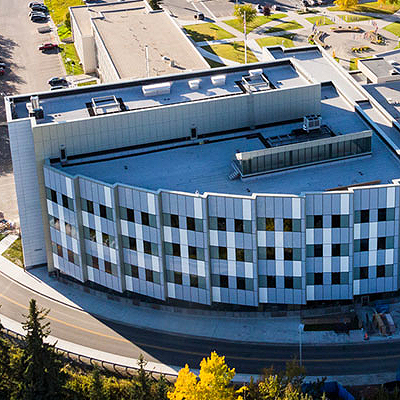 Join your peers at the Innovation Initiative, or I2, kickoff meetup on Wednesday, December 6th, at 4:00 p.m. on the fourth floor of the new engineering building – the Engineering
Learning and Innovation Facility (ELIF).
Join your peers at the Innovation Initiative, or I2, kickoff meetup on Wednesday, December 6th, at 4:00 p.m. on the fourth floor of the new engineering building – the Engineering
Learning and Innovation Facility (ELIF).
I2 will be a recurring event aimed at fostering innovation and entrepreneurialism by bringing participants from diverse backgrounds together in a fun and casual atmosphere.
The format and location for I2 meetups will vary with the goal of bringing together people from a range of backgrounds. Sometimes the I2 might feature a guest speaker, other times participants might seek fresh takes on challenges they’re facing, and the entrepreneurial-minded might use the forum to pitch their business ideas.
The first meetup will include an introduction to I2, guest speaker Ky Holland, and a social mixer starting at 5:00 p.m. Holland is a serial entrepreneur and investor, board member of the Launch Alaska business accelerator, and the newest member of UAF’s Intellectual Property Advisory Committee.
For more information on this event, please contact Peter Webley at pwwebley@alaska.edu.
 The staff at OIPC would like to wish you and your family a safe and happy holiday
season.
The staff at OIPC would like to wish you and your family a safe and happy holiday
season.
Our offices will be closed from December 25th through January 2nd, 2018.
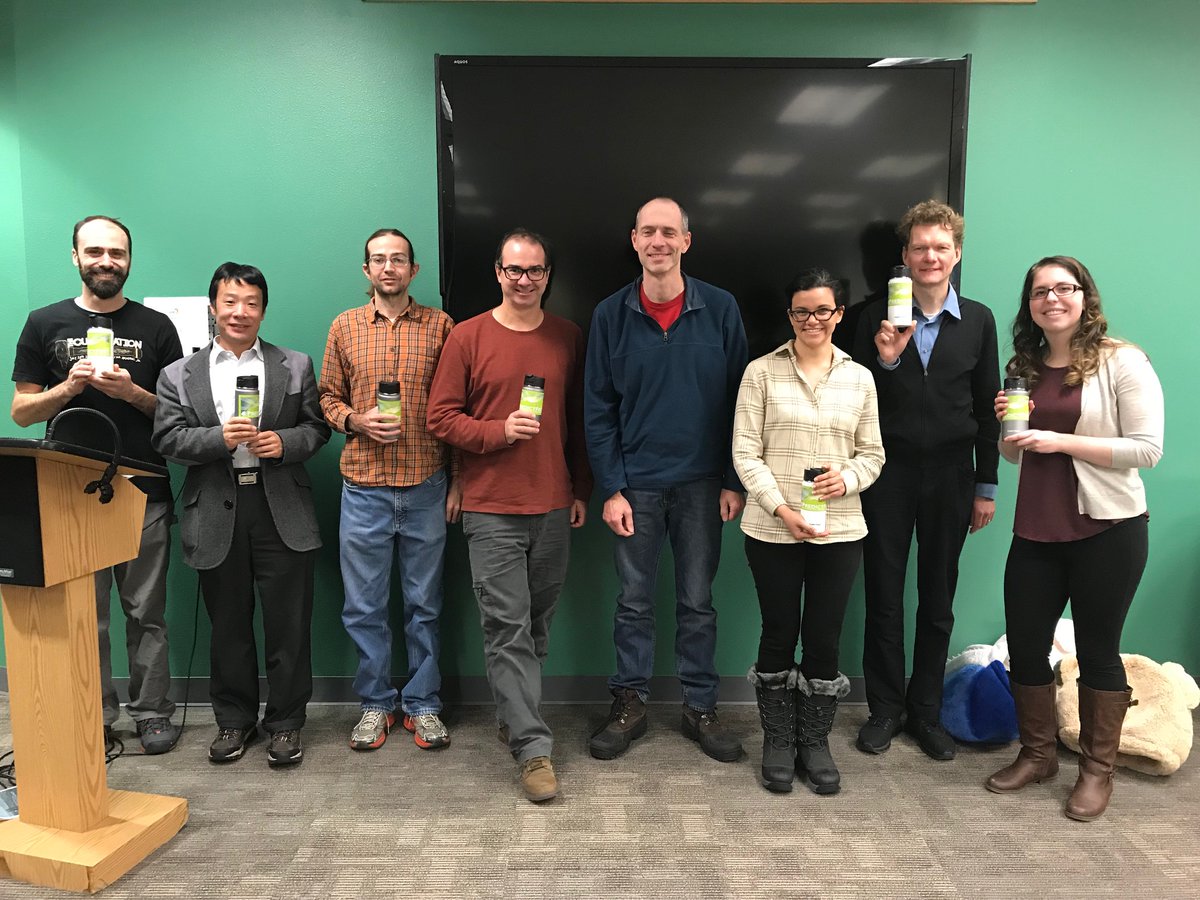
Team 1 created the App Arctic Weather. Photo courtesy of IARC.
How many more times will I have to plow my road this winter? How early will I be able to skijor next year?
Products developed by IARC researchers at this fall’s PredictFest can answer these question and also tackle challenges of greater significance.
Recently 30 IARC researchers gathered into 3 teams and spent 2 full days tackling a challenge, developing products, assembling business pitches, and even writing a song. This was PredictFest – a fast-paced, hackathon-style, friendly competition. Each team was given the same temperature and precipitation dataset and the simple game rules were set: quickly develop a product and business model, then be ready to pitch it in about 30 hours.
PredictFest was the idea of Erin Trochim, a postdoc at the Alaska Climate Science Center (AK CSC), and Lindsey Heaney of also with AK-CSC and Scenarios Network for Alaska + Arctic Planning (SNAP).
Hajo Eicken, Director of IARC, was impressed with the deliberate and strategic efforts that went into planning PredictFest, and even more impressed with the outcomes.
Eicken said, “These research products and ideas, when you combine them, are a fully viable model to build on, and to see whether we can take this to commercialization.”
The winners were the Winter Weather Outlook Services (WWOS) team who created a snow-depth prediction app that can compare historical data with predictions for the coming winter. This tool would help public and private entities to manage their business and personnel projections for the upcoming year. WWOS used strong data processing capabilities, presented a solid company idea, and formulated a business plan including exercising due diligence in looking at possible competing business ideas.
Mentors, including Dr. Ping Lan from the UAF School of Management, were available to help the teams create their business plans and marketing pitches.
Lan, impressed by the products and the business models, noted that “these are first class scientists, and they are capable of creating a first class business.”
Collaboration and networking was as important as the product design. In some cases, members of the same research group were meeting for the first time and developing working relationships that would follow them back to the respective offices.
Eicken added, “This exercise is a great way to help build networks from inside the teams, and when a problem arises in a research group, a department, or even at the university management level, this would be a great exercise to put resources toward that problem in a structured event that yields great results in a short amount of time.”
Reflecting on PredictFest, Trochim noted: “We all know how to do the research, but how do we translate that into a useful product.”
Trochim also noticed IARC researchers’ desire to collaborate more with other IARC research groups. Additionally, the event met some of the goals of IARC’s Experimental Arctic Prediction Initiative to promote professional development, produce innovative products, and initiate co-production.
OIPC’s Mark Billingsley and Gwen Holdmann, along with OIPC ambassadors Rajive Ganguli and Peter Webley, helped mentor the teams on day one and then served as judges at the end of the day two.
Commercialization of basic research is highly relevant right now. Commercialization can generically refer to developing new products and repackaging data with the goal of targeting new research sponsors. From that perspective, commercialization is a key to successfully diversifying research funding. More traditional commercialization – developing a product that can be licensed or sold – also has great potential to support research funding plus personally reward the inventor or author.
Next, organizers are looking at ways to expand the PredictFest model to a larger UAF community, and the winners are working further into commercialization.

OIPC recently launched a new website offering faculty, staff, students, and industry partners easier access to the information they need to disclose an innovation, get help with patent and copyright protection, and learn about UAF’s commercialization process. Check out the website now and let us know what you think!
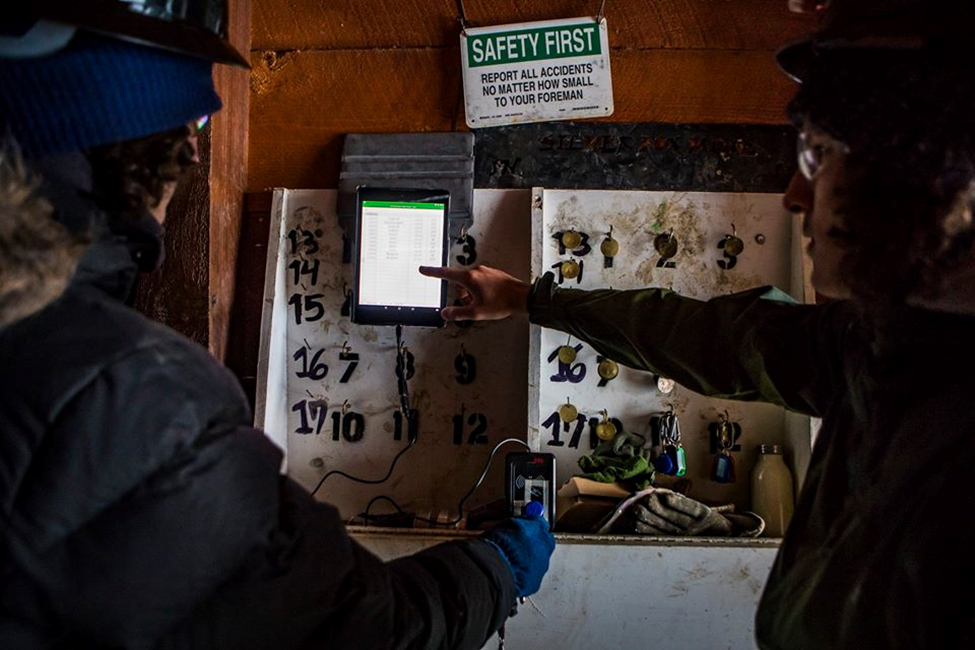
Aaron and Benjamin Rouse test their product the UAF Silver Fox mine. Photo by JR Ancheta.
The UAF mining engineering program is one of a handful programs worldwide that operates a training mine. The student-run UAF Silver Fox underground mine is located approximately 17 miles north of the main campus, off the Elliott highway.
Safety protocols at the mine require that entry and exit from the underground workings be logged. This requirement is typical of the mining industry. The current “check-in-check-out” (CICO) system consists of visitors logging their entry and exit into a notebook placed at the mouth (portal) of the mine. They also take a unique brass tag that would help identify them in case they are incapacitated. Managing the notebook, its location and physical condition, can be challenging as the Silver Fox is a volunteer run mine.
Early this fall semester, Rajive Ganguli, Professor of Mining Engineering and faculty ambassador for OIPC asked twin brothers and mining engineering majors Aaron and Benjamin Rouse if they would be interested in developing a solution to the problem. Dr. Ganguli presented some ideas including radio frequency identification (RFID) tags. The two brothers were excited and readily agreed.
“It was a great opportunity for me to see what I was capable of as a student” said Aaron Rouse.
The students obtained inexpensive RFID tags online and came up with the prototype solution within a month. In their solution, each mine visitor can be assigned a unique tag. The tag is scanned by a reader, which transmits the tag and time stamp information to a tablet/computer. The information is displayed using Microsoft Excel. The brothers worked with their mentor, Dr. Ganguli, to fine tune the information display including providing a quick analysis.
The prototype was deployed during a controlled blast conducted at the mine in October 2017. Representatives from Orica Explosives and Sumitomo Metal Mining Pogo, LLC, who helped with the blast, evaluated the prototype and provided feedback. The mining professionals were surprised to note the very low cost of the prototype, and they indicated that a robust version of the product could find a market in mines, as many mines still relied on traditional CICO systems.
The brothers have been working on the prototype and making improvements. They practiced their ‘sales pitch’ at the UAF Mineral Industry Research Laboratory booth at the Alaska Miners Convention in Anchorage last month.
“It was very difficult to develop a new thing, but we found a suitable technology that could be used for our project, and we were able to come up with a final product by applying our ideas” said Benjamin Rouse.
The brothers want to learn about the commercialization process to hopefully sell their product in the near future.
 The Invent Alaska Competition, hosted by the Vice Chancellor for Research, is open
to all UAF and UAS students, staff and faculty.
The Invent Alaska Competition, hosted by the Vice Chancellor for Research, is open
to all UAF and UAS students, staff and faculty.
Submit your invention disclosures NOW through April 27, 2018.
Do you have a technology that you would like to commercialize? Enter the Invent Alaska Competition for your chance to win!
The grand prize winner will receive $7,500 and assistance with protecting and commercializing their innovation. Separate categories exist for (1) innovations with the greatest commercial potential, (2) best early stage ideas, (3) student submissions, and (4) UAS submissions.
For more details, visit Inventalaska.com or contact OIPC at 474-2605.
2018 Innovation Summit
February 21–22, 2018 - Juneau, Alaska
The Innovation Summit is an annual event produced by the Juneau Economic Development Council to promote innovation and foster collaboration, productivity, and prosperity in Alaska. The Innovation Summit brings together hundreds of business owners, government employees, policymakers, NGO members and thought leaders to shape the economic future of Alaska. The event aims to bring together people from a range of industries and sectors, learn from outside perspectives and engage and connect to develop strategies that work for our region.
Right now Innovation Summit is seeking 30 presenters for the 10-minute Innovation Shorts as well as 5 Alaska entrepreneur/innovators for the Pitch Contest. Visit their website to take advantage of this great opportunity.
Launch Alaska
Summer, 2018
The Launch Alaska business accelerator is a cohort-based program to help high-growth businesses form and grow. It’s an intensive, 120-day process for companies to improve their operations, identify their market and product fit, learn how to innovate and iterate quickly, and become investment ready, scalable ventures. In the process, they form connections, get access to capital and mentors, and formulate and test their strategy in a supportive environment. From June through August, participants relocate to Anchorage and receive mentorship, business training, business services, and $25,000 in exchange for six percent ownership of their company. Apply now!
November
 The Invent Alaska Competition, hosted by the Vice Chancellor for Research, is open
to all UAF and UAS students, staff and faculty.
The Invent Alaska Competition, hosted by the Vice Chancellor for Research, is open
to all UAF and UAS students, staff and faculty.
Submit your invention disclosures NOW through April 27, 2018.
Do you have a technology that you would like to commercialize? Enter the Invent Alaska Competition for your chance to win!
The grand prize winner will receive $7,500 and assistance with protecting and commercializing their innovation. Separate categories exist for (1) innovations with the greatest commercial potential, (2) best early stage ideas, (3) student submissions, and (4) UAS submissions.
For more details, visit Inventalaska.com or contact OIPC at 474-2605.
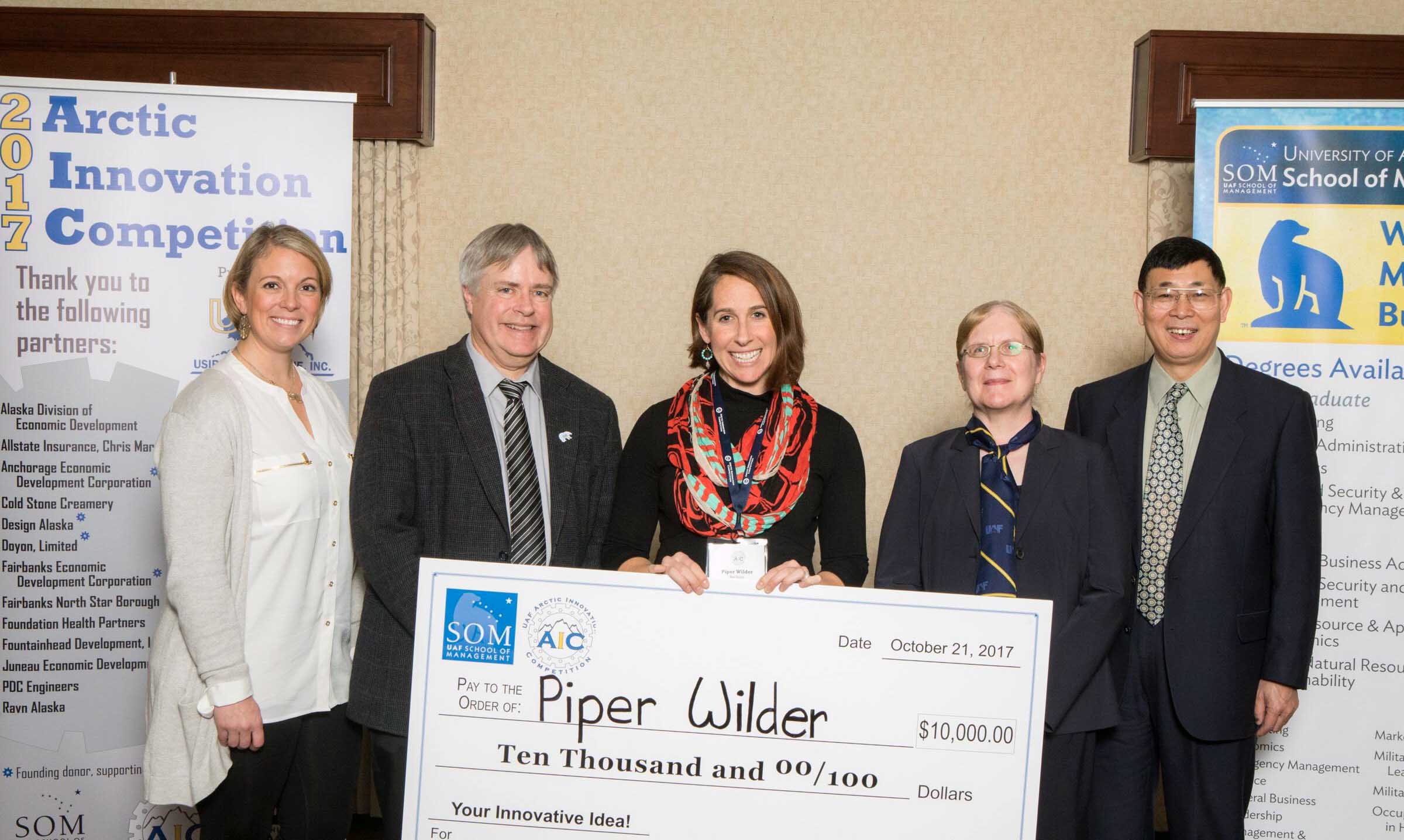
AIC winner Piper Wilder accepts 1st place with 60Hertz Microgrids. Photo by JR Ancheta/UAF.
Being innovative is in our blood here in the Arctic. Throughout the year, numerous innovation and entrepreneurial events across the state, from hack-a-thons to innovation summits and business plan competitions, spark new ideas.
In Fairbanks, following last month’s Startup Weekend, the next event on the 2017/2018 Year of Innovation calendar was UAF School of Management's Arctic Innovation Competition (AIC), ‘Alaska’s Original Idea Competition’ on October 21, 2017 at Wedgewood Resort.
A packed Borealis Room watched as the 15 Main Division semi-finalists presented (“pitched”) their ideas and innovation, fielding questions from the judges. The audience then had the opportunity to hear from the five Jr. (ages 13-17) and three Cub (12 and under) division finalists, with the honorable mentions also being given the opportunity to give the judges a short pitch on their idea.
This year the Jr. and Cub divisions had a flood of entries, with 57 just in the Jr. Division alone. In the Cub division, one of the honorable mentions came from the competition’s youngest contestant, 7-year-old Luke Karpik and his ‘Drone Emergency Survival Kit’. This shows how the AIC is captivating the next generation of Alaskan innovators.
The AIC is presented by Usibelli Coal Mine, and judges for each division came from across the Fairbanks and Alaska business community.
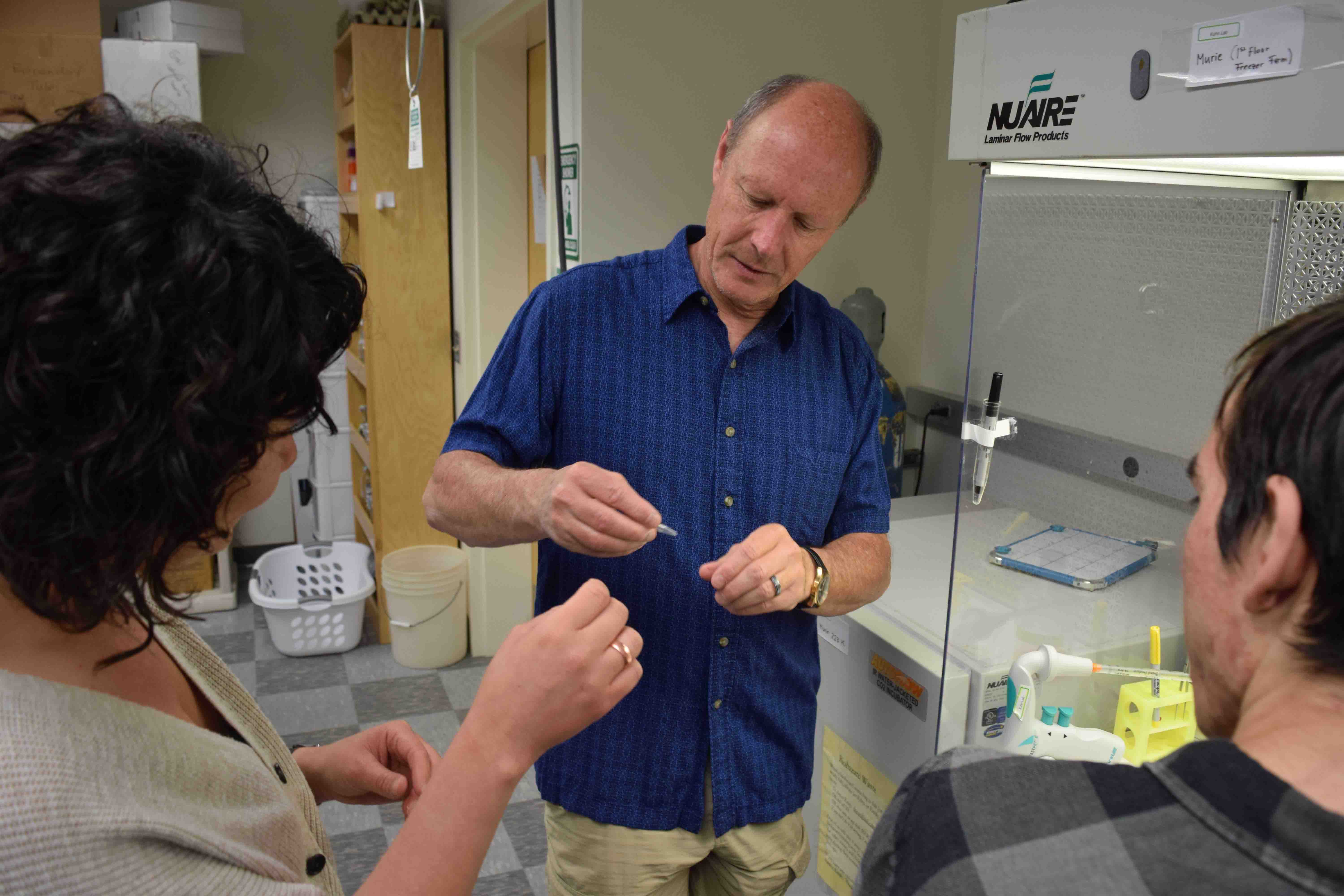
Dr. Thomas Kuhn shows students a sample in his lab. Photo by Amy Topkok/BLAST
Blueberries may never look the same to you again after reading this. In fact, blueberries may change how you see the whole world by improving your cognitive abilities as you age.
Professor Thomas Kuhn, from the Department of Chemistry and Biochemistry, is researching whether Alaskan blueberries can be made into a ‘functional food,’ or a food with healing properties. We’ve heard about antioxidants in blueberries, but Kuhn’s research is taking a different angle: looking at using blueberries to improve mental health and cognition in aging brains.
Kuhn’s research focuses on a key component of blueberries that, when concentrated, may help reduce brain cell stress caused by a loss of neurons and neural connections, which in turn reduce cognitive ability and precede the onset of chronic neurological disorders such as Alzheimer’s and Parkinson’s diseases. Developing the concentrate is a key hurdle, as effective concentrations may require the equivalent of as much as three gallons of blueberries a day!
Kuhn and his wife Julia have formed a company, Cereon Biotechnology that is aiming to develop the functional food into a product that can be included in, for example, beverages and supplements.
The Kuhns formed Cereon Biotechnology not just to pursue commercialization but also because research on functional foods is not commonly funded through conventional grant sources. Through the business, the Kuhns had access to Small Business Innovation Research (SBIR) grants.
In 2017, Cereon Biotechnology was awarded a Phase I SBIR grant through the USDA for research pertaining to improving the functionality and efficacy of foods promoting health.
Next, Cereon Biotechnology will apply for a Phase II USDA SBIR grant to fund a prototype of the product. Then the prototype can be patented and licensed through OIPC for use in FDA approved consumer products.
Cereon is one of a growing number of high-tech startup companies in Fairbanks. Focusing on resources like Alaska blueberries wisely capitalizes on Alaska’s strategic advantages. Perhaps the humble Alaska blueberry will add to the momentum and help guide the development of Alaska’s economy of the future.
October
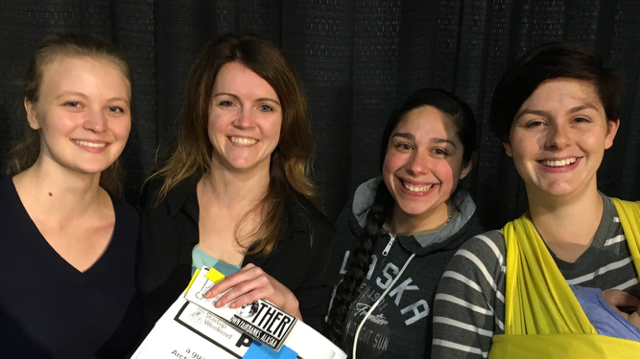
Cubhouse Team Members. Photo by Juliet Shepherd/FEDC.
Startup Weekends are a hands-on learning environments where ideas or concepts are pitched to a room full of fellow up-and-coming entrepreneurs and innovators. The ideas are voted on to further develop the best four or five ideas. At Startup Weekend Fairbanks, most of the ideas focused on solving Alaska-based issues.
Aditaya ”Adi” Akheramka says, “Startup Weekend is more about learning the skills and process to develop an idea into a sustainable business, more than actually developing the idea. It helps you form a team and make the connections necessary to take your idea to the market.”
Adi is a Master’s student in Petroleum Engineering, and a member of Active & Innovative Minds (AIM), a cross disciplinary student organization based in the UAF School of Management. Last year, Adi participated in Startup Weekend Fairbanks. This year he took the role of an organizer, encouraging other UAF affiliates to participate in the event.
This year, around 25 participants converged at The Hub in downtown Fairbanks, a coworking space for entrepreneurs, non-profit and business professionals, as well as start-up teams, and pitched their ideas, each holding a white cardboard sign displaying their concept. The participants included 8 UAF students, 4 military spouses, 3 adults aged over 60, and 10 general public participants.
The event was facilitated by Nigel Sharp, a leader in technology integration, product development, marketing approaches and entrepreneurship and the Global Entrepreneur in Residence (GEIR) at the University of Alaska Business Enterprise Institute.
The four ideas selected by the participants for further development during this year’s
event were:
Cubhouse – A safe and engaging space for kids and families to socialize outside of
the home. Their slogan is: Eat. Drink. Play!
Catch-a-Nap – A student’s concept of a mobile sleep-pod, where a noise canceling-equipped
hoodie and backpack lets students or travelers take a quiet nap in noisy places
Alaska Fresh – Locally grown herbs and vegetables produced for the Fairbanks community.
Alaska Fishbowl – A prototype space where students can use 3D, augmented reality, Ironman-esque optimized design technology to develop and prototype their ideas.
The idea that was most surprising and unexpected to Adi was aimed at creating a shelter space and designing a 6-month program for challenged kids transitioning back into society.
Adi says, “The reason this was unexpected was because it was a not-for-profit idea, where most ideas pitched are for profit.”
This year, the teams took their concepts to the public for intensive market surveys in areas where the idea might be best used. For example, the Cubhouse team surveyed patrons at the Fairbanks Children’s Museum, while Catch-a-Nap folks pounded the streets on the UAF campus.
On Saturday, a host of mentors from manufacturing, marketing, sports, and financial sectors spent time with each team answering questions related to their expertise and providing the team with feedback to develop their ideas.
On Sunday evening, the teams who had spent Saturday and Sunday honing their product and concept ideas, gave their final pitches to a panel of judges at the Alaska Universal Productions building in Fairbanks.
Cubhouse won the pitch, and won a direct entry into the Arctic Innovation Competition (AIC), which will happen on October 21st.
Some past winners of Startup Weekends in Alaska have gone on to win the AIC, and join the Launch Alaska (L:A) Accelerator, with the most recent being 2016 Fairbanks winners Attently, one of the current cohorts in L:A. The timing of these events is not coincidental. In fact, they have been planned to feed into each other, to help spur on the innovation found in the Arctic and build the Year of Innovation across Alaska.
The Year of Innovation was the brainchild of Juliet Shepherd of Fairbanks Economic Development Corporation and was developed in partnership with Ky Holland of Alaska Pacific University.
To find out more about Startup Weekends in Alaska, or any of the innovations events during the 2017 - 2018 Year of Innovation, visit Innovate Alaska.
 The University of Alaska was awarded a $25,000 Economic Opportunity Grant from Wells
Fargo. The University of Alaska was awarded this funding to help create an early-stage
Alaska Innovation Pipeline that will encourage and support local entrepreneurship.
The pipeline will be developed as part of a collaboration between UAF’s School of
Management, the Alaska Center for Energy and Power, and the Office of Intellectual
Property and Commercialization. Stay tuned for more details as we roll out this exciting
new program!
The University of Alaska was awarded a $25,000 Economic Opportunity Grant from Wells
Fargo. The University of Alaska was awarded this funding to help create an early-stage
Alaska Innovation Pipeline that will encourage and support local entrepreneurship.
The pipeline will be developed as part of a collaboration between UAF’s School of
Management, the Alaska Center for Energy and Power, and the Office of Intellectual
Property and Commercialization. Stay tuned for more details as we roll out this exciting
new program!
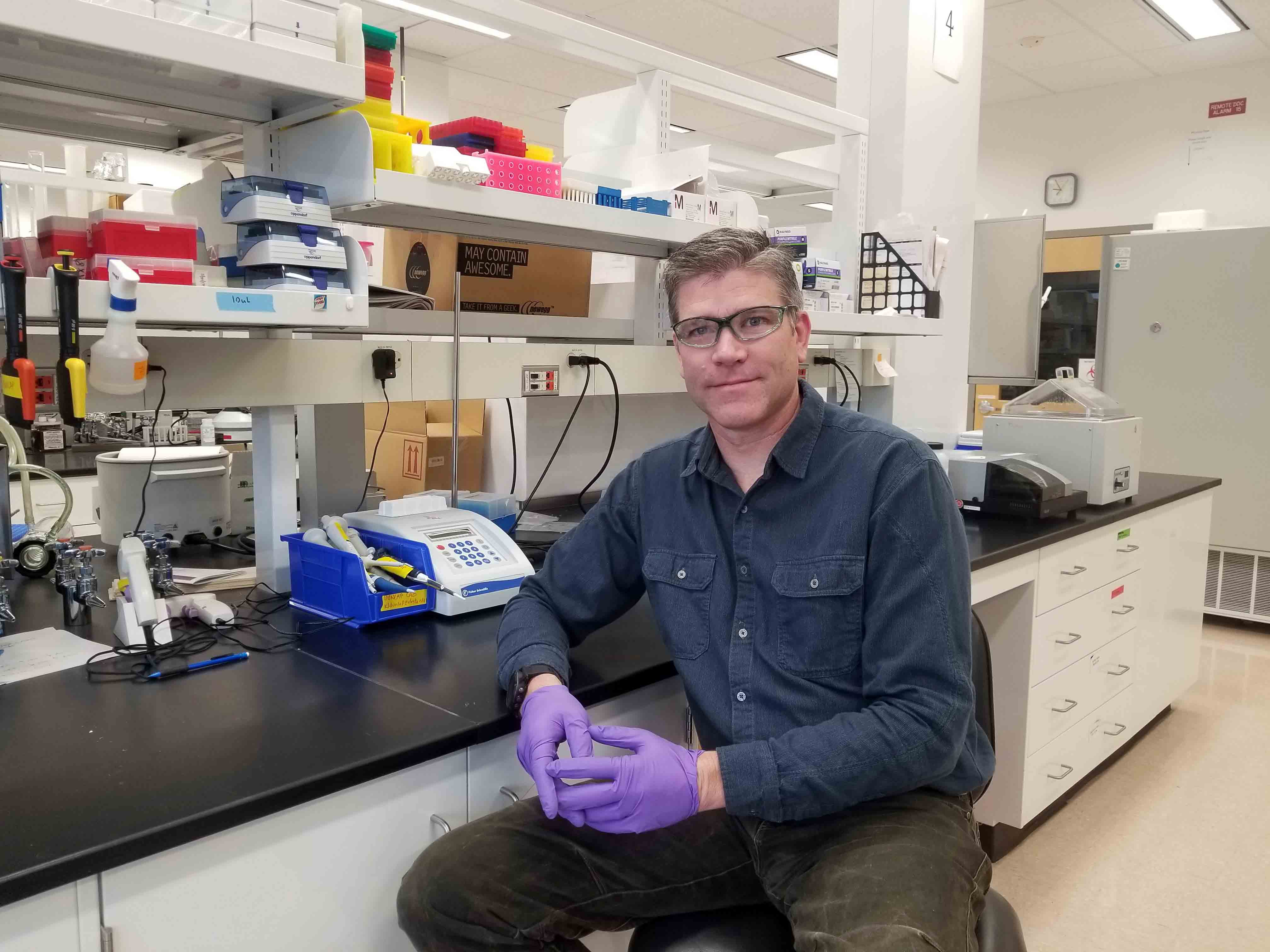
PhD Candidate Scott Jerome in his laboratory. Photo Amanda Byrd/OIPC
Vitamin D is something we all think about leading up to winter in the sub-arctic. Over training, however, is not something many people associate with themselves, though the two may be linked.
Over Training Syndrome (OTS) is what UAF Biochemistry PhD candidate Scott Jerome is researching for his PhD using the UAF Nanook ski athletes.
Jerome is a non-traditional student. At 47 he has 18-years of elite level coaching in his background including ten years as the Head Coach for the UAF Nanooks. While he has worked with elite athletes, his interests lie in human health and performance at all levels of fitness.
Jerome says, “I’m interested in how young people use sports and athletics as a way to set a foundation for life.”
This foundation Jerome references is based on a well-rounded lifestyle, eating a healthy diet, getting enough sleep, and a good working and family life.
With physical education programs in the school system waning due to budget cuts, Jerome believes it is more important than ever to work with young people to help them achieve the 2000 year-old Greek philosophy Healthy Body Healthy Mind.
For his PhD, Jerome is researching OTS, an ailment that generally affects national and international-level elite endurance athletes. OTS is defined as an unexplained drop in human athletic performance.
Jerome says, “it is the undiagnosed diagnosis, after every possible other diagnosis, such as anemia, negative caloric balance, or viral or bacterial infection, has been eliminated.”
To help predict who is at the greatest risk of developing OTS, Jerome is looking at developing a cohort of biological and psychological markers.
One of the markers being considered is vitamin D, which is linked to muscle regeneration and repair. Vitamin D is naturally absorbed through the skin from the sun’s radiation.
During the research it was found that in Fairbanks, where vitamin D intake during the winter months is lower due to the low sunlight and small surface area of exposed skin, vitamin D intake is higher in elite athletes (involved in college cross country skiing) than their sedentary counterparts (not involved in skiing) on campus.
However, it was found that the athletes who took in more vitamin D had lower vitamin D stores.
Other related studies looked at vitamin D and psychological skills during the cross country ski and the production of free radicals in the mitochondria.
In addition to working toward attaining his PhD, Jerome is using his coaching skills to mentor BLaST undergraduate scholars in their own biomedical research.
UAF’s Biomedical Learning and Student Training (BLaST) program increases the capacity for undergraduate biomedical research training and efficacy for engaging students from diverse, especially rural Alaskan, backgrounds in education and training for biomedical research careers.
BLaST is funded by the National Institutes of Health and is a national program that targets under-represented, minority populations who generally do not receive NIH grant awards.
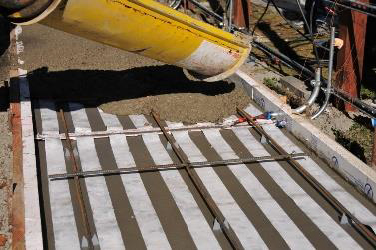
Tundra Tape is embedded in concrete. Photo courtesy of arcticheattech.com/
We’ve all been there, that moment when you step down onto an ice-glazed sidewalk and your foot loses its grip. It doesn’t take too long before you are laying on the ground.
A visiting parent’s thumb-breaking slip on the ice was the moment that sent an idea on a journey to become a start-up business.
UAA Professor and Chair of Civil Engineering, Joey Yang, thought that there had to be a solution to icy walkways that led to the slip that broke his father-in-law’s thumb.
The idea spurred the development of Tundra Tape - a carbon fiber tape embedded in concrete to heat the surface using either islanded renewable or grid-connected power to thaw the ice from the surface.
Yang says, “We saw the potential of this technology when comparing the tundra tape with what is in the market (hydronic system with heated glycol circulating in PVC pipes, and heat trace). Our system is more reliable and efficient and has great potential in helping the northern cities tackling the ice issues."
A recent story in the Alaska Journal of Commerce noted that this was just one of four start-up companies based on the research of UAA faculty. The Tundra Tape product, owned by start-up company Arctic Heat Technologies, Inc., is now working on UL listing this product for commercializing this market, and the Alaska Department of Transportation is eyeing the product for cross walks, ramps, and bridges. Arctic Heat Technologies, Inc., is an example where the research conducted in a university can lead to a marketable product.
If you have an idea that was generated from your research, contact OIPC and we can help move your idea to a marketable product.
September
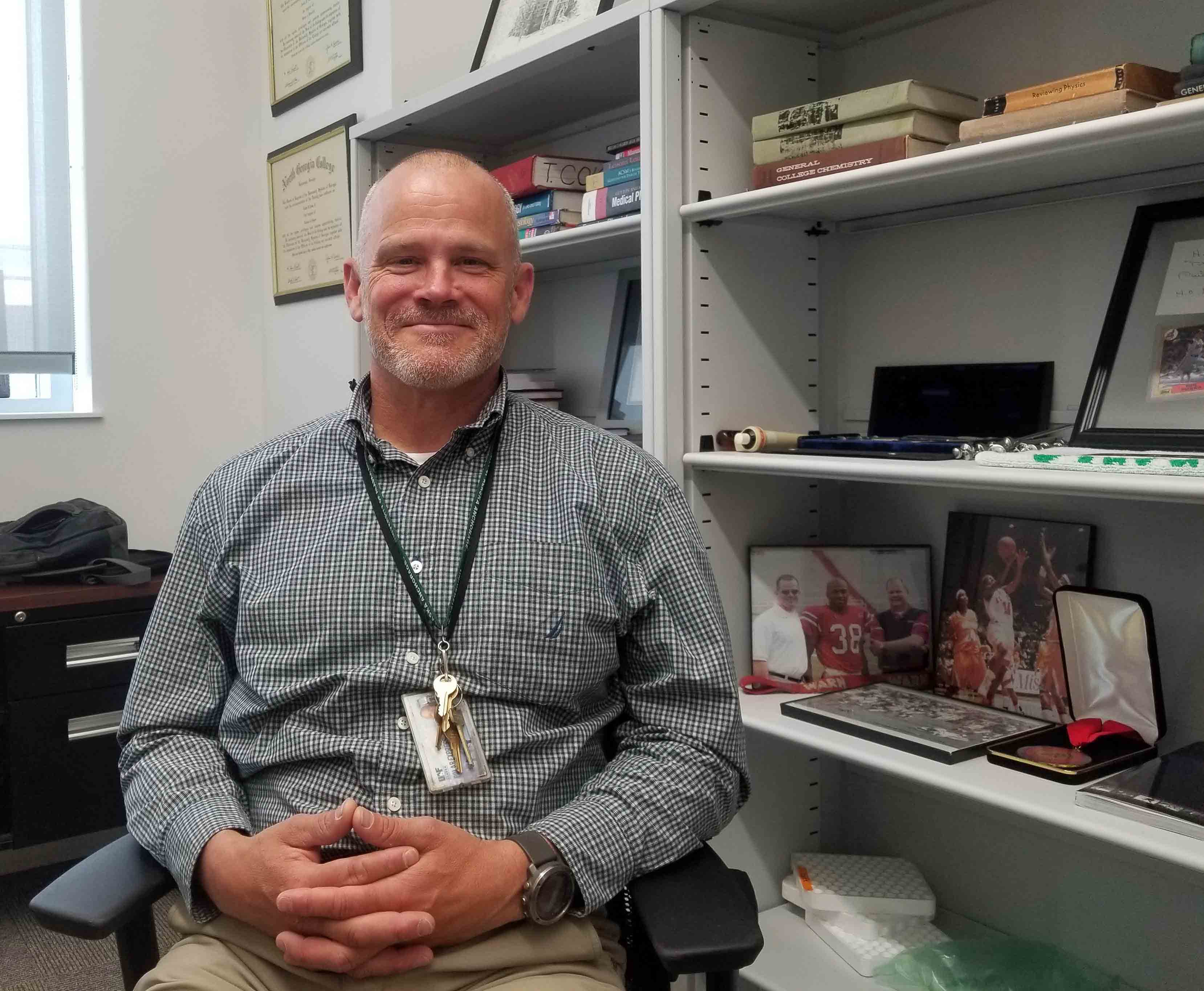
Dr Robert Coker has used his biomedical research to start a business using SBIR and STTR grants. Photo Amanda Byrd/OIPC
Just a month before joining UAF in 2013, Robert “Trey” Coker used his innovative research to start a small business.
The idea for the company, Essential Blends, arose through journal papers that he and his collaborators were publishing in the biomedical literature. While noteworthy in an academic sense, the benefits of their work was not getting to the people that needed it.
Coker’s company promotes the development of condition-specific nutrition. One of the nutrition products helps treat alcohol use disorders where a fat that accumulates on the liver leads to a decrease in liver function, and another one helps maintain independence in the elderly through preservation of skeletal muscle.
Helping sick people has been one of Coker’s main research goals, and translating science is one of Coker’s greatest passions. He feels the only way the public values scientific innovation is when they understand how it can benefit them or their family/friends. If the innovator has not done a good job decoding the scientific jargon, then they miss the point.
Coker says, “This is why innovation and commercialization is so important because it allows researchers to translate science so that they value and appreciate the information.”
When Coker and his Essential Blend business partners evaluated start-up funding options they included angel investments among other options. They decided to pursue federally funded Small Business Innovative Research (SBIR) and Small Business Technology Transfer (STTR) grants. These funding options provide a source of funding without diluting the ownership of the company. This gives the company owners more control of their company and keeps their eye on the target.
Many federal agencies including NIH, USDA, NSF, DOE, and many more have SBIRs and STTRs and they are a great way to promote innovation and commercialization, even outside the typical academic setting.
Coker has tried to build a reputation with innovation and commercialization at UAF by partnering with Essential Blends, which he is a minority partner, to create products that can developed and promoted exclusively through UAF.
Through Essential Blends, Coker has eyed the strength of the new program in Veterinary Medicine, and made anintellectual property disclosure with UAF titled MyoCanine that is a canine food product that helps maintain skeletal muscle while reducing fat in obese animals.
His research is not confined to classic clinical laboratory settings, and Coker has started to look at surrogate models of military operations in cold environments using extreme events like the Yukon Arctic Ultra 430 mile billed as the longest and coldest ultra in the world. Coker collaborates with the Center for Space Medicine in Berlin Germanyto help understand the importance of nutrient delivery during the physiological scenarios in the Arctic. This research in a dynamic field setting is directly translatable to military operations.
Coker is currently using Magnetic Resonance Imaging/Spectroscopy (MRI/MRS) technology to measure beneficial alterations in liver metabolism linked to nutrient supplementation in metabolic disease. Also, he using this technology to evaluate potentially detrimental reductions in the skeletal muscle of wildland firefighters over the course of an increasingly long fire season in Alaska.
For more information on this or any other of Dr Coker’s research.
OIPC has developed an Innovation Ambassador program at UAF to foster innovation and creativity.
Our ambassadors are innovators themselves. They have been selected to represent their UAF departments to encourage and foster students, staff and researchers to develop their research into marketable products.
If you see either of our Ambassadors at an event around campus, take the opportunity to introduce yourself and learn more. They too will be looking for you: UAF's brightest minds with the next ideas that will help shape our world.
The 2017/18 Ambassadors are:
Rajive Ganguli
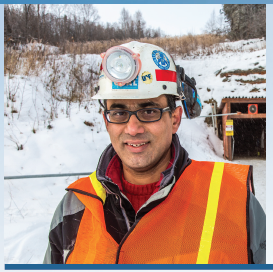 Dr. Rajive Ganguli is a Professor of Mining Engineering and Director, Mineral Industry
Research Laboratory at UAF.
Dr. Rajive Ganguli is a Professor of Mining Engineering and Director, Mineral Industry
Research Laboratory at UAF.
Ganguli was admitted to the Alaska Innovators Hall of Fame in 2017 for his work on a dynamic mill simulator that is intended to train mill operators at a mine site.
Through his private consulting and university research, Ganguli has developed software products for systems engineering and process optimization applications for mining companies in Alaska and elsewhere. He holds a patent for an algorithm for physical segregation of coal. Dr. Ganguli is a strong believer that even research conducted in academic environments can have practical applications.
Contact Dr. Ganguli at rganguli@alaska.edu
Peter Webley
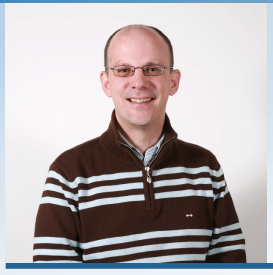 Dr. Peter Webley is an Associate Research Professor of Remote Sensing at the Geophysical
Institute, UAF.
Dr. Peter Webley is an Associate Research Professor of Remote Sensing at the Geophysical
Institute, UAF.
Webley is a sought-after expert on natural hazards events, is committed to supporting and developing entrepreneurs and innovators at UAF, UA, and across Alaska.
He was one of seven inductees to the Alaska Innovators Hall of Fame in 2017 for his expertise and work in volcanic hazard mapping and assessment, developing UAF's first start-up company from IP, V-ADAPT, Inc., and as a patent holder for a new method of validating the accuracy of particle-cloud-forecasting transport and dispersion models.
Dr. Webley is excited to engage with faculty, staff, and students at UAF in developing and commercializing their innovative research.
Contact Dr. Webley at pwwebley@alaska.edu


